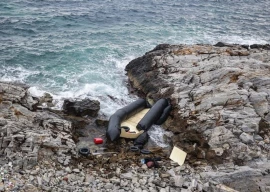
Astronomers initially thought the object was an asteroid when they spotted it in early October, and named it Asteroid 2015 TB145.
NASA unveils missing pieces in journey to Mars
But using the US space agency's Infrared Telescope Facility (IRTF) on Mauna Kea, Hawaii, experts "have determined that the celestial object is more than likely a dead comet that has shed its volatiles after numerous passes around the sun," NASA's Jet Propulsion Laboratory said in a statement late Friday.
 The comet 67P/Churyumov-Gerasimenko, taken on September 19 when Rosetta was 28.6 km from the comet. PHOTO: AFP
The comet 67P/Churyumov-Gerasimenko, taken on September 19 when Rosetta was 28.6 km from the comet. PHOTO: AFPScientists have also spotted an eerie skull-like resemblance on the face of the rock, based on radar data from the National Science Foundation's 305-meter (1,000-foot) Arecibo Observatory in Puerto Rico.
"In the Arecibo images it appears to have donned a skull costume for its Halloween flyby," said Kelly Fast, IRTF program scientist at NASA and acting program manager for the US space agency's Near-Earth Object Observations Program.
Asteroid will not destroy Earth next month: NASA
The space rock has already grabbed attention with its unusually high speed and big size, about as large as a football stadium at 2,000 feet (600 meters) in diameter.
There is no danger of it hitting Earth, however.
When it zips by Saturday at 1 pm (1700 GMT), it will do so at a distance of 302,000 miles (486,000 kilometers).
That's about 1.3 times the distance between the Earth and the Moon.



1723032398-0/BeFunky-collage-(36)1723032398-0-165x106.webp)













COMMENTS
Comments are moderated and generally will be posted if they are on-topic and not abusive.
For more information, please see our Comments FAQ